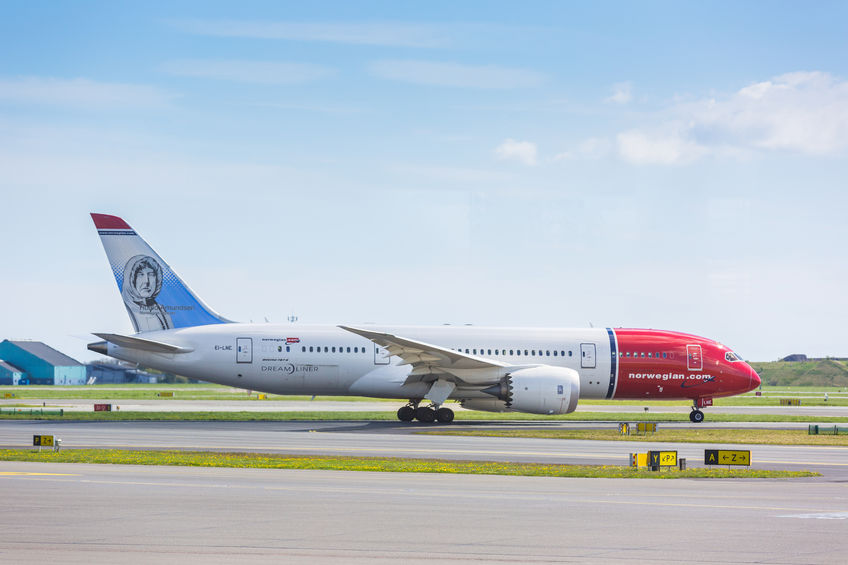Low cost airline Norwegian has struggled, in part because of the brutally competitive low cost transatlantic market, in part because of high costs at the airline, and in part by bad luck – the grounding of the 737 MAX, the long-term stranding of a plane in Iran, major engine retrofit work that was required for many of their aircraft.
They looked like they were in a perilous position a year ago. They brought in new financing and were well-positioned to make it through the winter. I had advised travelers not to worry about booking them over the summer. That’s when they should be making money. The question was whether it would be enough money to last them through early 2021. And this was before the coronavirus pandemic. On March 6 I identified Norwegian’s failure as a coronavirus risk.
Norwegian didn’t have the flush summer they’d hoped for to accumulate cash to survive, and now their CEO acknowledges “we don’t have the financial muscle to get through the winter.”

Copyright william87 / 123RF Stock Photo
This makes it almost laughable that this week they’ve touted a commitment to reduce CO2 emissions by 45% by 2030, there’s risk they could reduce CO2 emissions 100% by 2021.
The airline has been pulling out all stops to avert a shut down for some time – they were mere days away from collapse at the end of 2018. Two years ago British Airways bought a small piece of the airline to get a good look from the inside as they considered acquiring and killing the low fare competitor. Instead they left Norwegian to – they hoped – fail on its own.
They restructured costs, giving aircraft lessors a stake in the company. They got a $341 million government bailout. They declared four subsidiaries bankrupt. Now they’re looking for another bailout from the Norwegian government.
The airline believes it still has a viable business, even if it could take until 2025 to turn around. Airlines have generally been able to access capital markets during the pandemic. At some point more airlines will fail, though, and Norwegian has raised its hand as continuing to be one of the most vulnerable.


What does “reduce emissions 1005 by 2021” mean?
@ Jason:
He meant 100%. The percent sign is on the “5” key.
The sooner they disappear the better. Since their inception they have been playing a big shell game to get to access to lucrative international routes by circumventing normal protocols while governments such as the US have done nothing to protect their international carries. This way before the current Covid crisis and it now exponentially worsens the impact and the he comeback prospects of the existing carriers who had to “play by the rules” for decades.
I’m being redundant here but, I’ll say it again anyway. The perfect ‘savior’ for Norwegian is Ryan. Gives Ryan a huge gateway into some North American markets that can match up to some of their existing strongholds on the European continent. And as we all know, Ryan knows how to run an ULCC.
In a normal M &A business, this would give Ryan an excellent opportunity to do some serious ‘bottom fishing’. Wish I would have thunk about it sooner
@TW: it is not the job of the US govt. to protect existing carriers. On the contrary, consumers benefit from competition and the government should preserve and strengthen that.
Norwegian Air isn’t in trouble because of the competitive low cost Transatlantic market or because of the MAX grounding. Norwegian Air was in trouble long before the MAX grounding but they had billionaire investors who continued to pour money into a troubled airline hoping to recoup their investment.
From the onset Norwegian’s problem in the long haul international market was they never covered their operational cost. In order to attract and steal passengers from other airlines Norwegian Air always priced their ticket lower than cost. Norwegian Air operated routes for years at a lost and instead of trimming their international schedule to rightsize the ship they continued to expand believing they could expand their way into profitability. When Norwegian Air came to Chicago and launched service to London they were selling round trip regular coach seats for $235 dollars including tax. Anyone who has flown internationally know taxes and government fees are a lot. How much of that $235 dollars went towards taxes and how much we towards covering Norwegian’s cost to operate the flight? Compare Norwegians price to BA, AA, VS, and UA they were a bargain and attracted a lot of passengers because the legacy carriers were all chargin $800 dollars or more for coach.
The low cost model works when implemented correctly but what Norwegian wanted to do was to cut off the legacy carriers at the knee caps thinking it would work and their strategy backfired because they never covered their operational cost.
Norway is the richest country on the planet. They will bailout the airline like they did last time. As a customer, having flown to Europe 6 times, I love their bargain rates and superb service. I was always flown on their Boeing 757 Dreamliners, new beautiful, roomy planes, always full. I hope they make it somehow or my trips to Europe are over.
A shell game company, looking to take shortcuts while taking no responsibility. Like the rest of Norway, which didn’t want to fully join the EU yet wanted to take part of its benefits, Norwegian Air Shuttle set out to be a cherry picking operation: Hey, let’s convenience-flag from Ireland for the overseas routes!
Then, IAG made multiple generous offers to buy DY well above market valuation, yet the intoxicated DY management said nyet… Now pay the price DY, and die already. Your parasiting won’t be missed.
That said, I do feel for the folks that are laid off and sincerely wish them the best going forward.